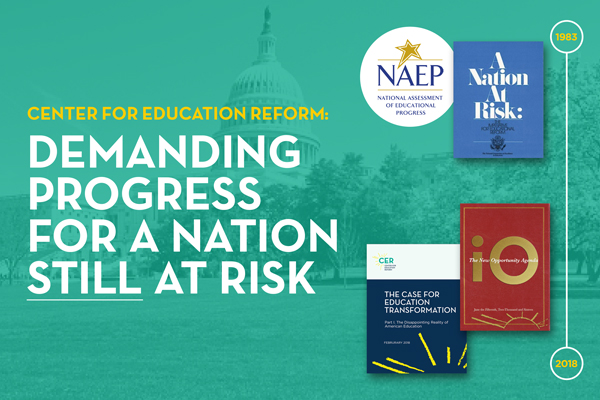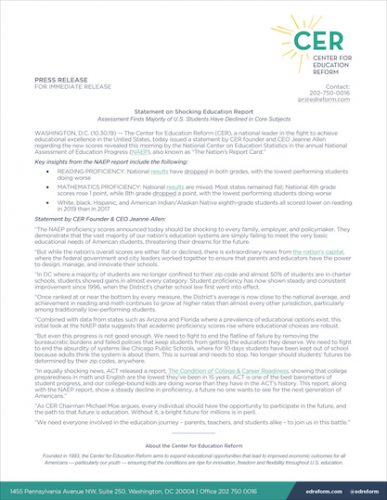A Nation Still At Risk? Results From The Latest NAEP

2022
RECORD EDUCATION DROP IS
“ACADEMIC MALNOURISHMENT”
Latest NAEP Scores Are More Than Pandemic-related
The results of today’s National Assessment of Educational Progress (NAEP) show a massive decline in student achievement. One out of three students cannot do math or read at grade level. One out of four students are not able to perform even at minimal, basic levels. According to the report’s authors, “the national average score declines in mathematics for fourth- and eighth-graders were the largest ever recorded in that subject.”
“This record plunge on NAEP scores is a continuation of bad education policy, pandemic or not,” said Jeanne Allen, Founder and CEO of the Center for Education Reform (CER).
“This is academic malnourishment.”
Continue Reading CER’s Full Statement
2020 RESULTS ON HISTORY, CIVICS & GEOGRAPHY ASSESSMENT
The results of the latest nation’s Report Card reveal that only 15 percent of 8th grade students are proficient in history, and fewer than 24 percent and 25 percent are proficient in civics and geography, respectively. The scores disaggregated by race are more stark – with fewer than 50% of white students and only between 10-20% of minority students meeting proficiency levels depending on the subject.
The results should startle Americans.
Said Peggy Carr, the associate commissioner of the National Center on Education Statistics which administers the Nation’s Report Card: “The results provided here indicate that many students are struggling to understand and explain the importance of civic participation, how American government functions, the historical significance of events and the need to grasp and apply core geographic concepts.”
Just last fall, both math and reading assessments revealed that student achievement was either flat or dropping for most US students. There had been no significant change from the prior 2017 assessment in math and marked decreases in reading. Reading scores were lower in more than half of the states at grade 8 since 2017.
Continue Reading CER’s Full Statement
Read CER’s Statement on the 2019 Nation’s Report Card.
Presented here are past and present reflections on that path breaking report, along with critical analysis of the past administrations of the National Assessment of Educational Progress (NAEP) and trends of improvement, pockets of persistent stagnation and CER’s assessments and recommendations for the innovation needed to drive real change. Stay tuned for more analysis on the 2019 winners and losers on what is called the “Nation’s Report Card”.
NAEP & A NATION AT RISK
Nation at Risk – The Imperative for Educational Reform
A ‘Nation at Risk’ issued in 1983 was a national call to action. In 1983, the report declared that “the educational foundations of our society are being eroded by a rising tide of mediocrity that threatens our very future as a Nation and a people.”
In the wake of the report, states scrambled to respond. They changed curriculum, adopted standards, lowered class size, increased salaries and funding, provided modest choices for parents not satisfied with their local public school…(over time they’d provide more); states did just about everything they thought would solve the problems.
But how did that go? In 1998, a group of education reform leaders led by CER and former Education Secretary William J. Bennett, assembled to review 15 years of progress of the pathbreaking report that once declared US education to be “a rising tide of mediocrity.” The report we issued, A Nation Still at Risk (1998) found the state of education remained woefully inadequate but with promise for the future if we could be bold enough to change the way we deliver schooling and the expectations we hold of all involved.
Last year, on the 35th anniversary of the release of ‘A Nation at Risk’ the latest NAEP scores were yet again a sobering reminder that far too many children and young adults are not well educated, prepared to enter college or the workforce, and ultimately, able to achieve the level of prosperity this nation offers and makes possible for every citizen.
And now, as we look on the latest results, we again recall the Nation at Risk report’s caution, that “If an unfriendly foreign power had attempted to impose on America the mediocre educational performance that exists today, we might well have viewed it as an act of war. As it stands, we have allowed this to happen to ourselves.”
2019 STUDENT SCORES IN 4TH AND 8TH GRADE READING AND MATH WERE EITHER FLAT OR DECLINED. THERE WAS ONLY ONE MAJOR BRIGHT SPOT – WASHINGTON, DC, WHICH SHOWED GAINS IN ALL FOUR COMBINED CATEGORIES.
IN ALMOST EVERY CASE, FEWER THAN 40 PERCENT OF OUR STUDENTS LACK PROFICIENCY IN BASIC SUBJECTS, THE GATEWAYS TO SUCCESS IN COLLEGE AND CAREER! Only 35 percent of 4th grade and 34 percent of 8th grade students performed at or above the Proficient level in NAEP reading, and 41 percent of 4th grade and 34 percent of 8th grade students performed at or above the Proficient level in NAEP math. These results reflect a decline of two percentage points in 4th grade reading and 8th grade reading, no gain in 8th grade math, and a one percentage point gain in 4th grade math – which is not statistically significant – compared to the most recent previous NAEP assessment in 2017.
Scores for African-American, Hispanic and at-risk youth are even more troubling.The following graph shows the national average and the overall scores in DC as well as two other state leaders whose robust choice environment suggests higher than average levels of growth statewide, as well as among minority students, being attributed often to charter schools. (Analysis and data about these scores will be available shortly.)

GET ACTIVE!To stay up-to-date, to advocate and to help us set this straight, sign up for CER Newswire |
PRIOR YEAR NAEP ANALYSIS: FROM THE 2017 ASSESSMENT IN READING AND MATH, RELEASED ON APRIL 10, 2018.
In 2015 thirty-six percent of fourth-grade and 34 percent of eighth-grade students performed at or above the Proficient level in NAEP reading (2015 NAEP reading assessment).
In 2017, it’s a dismal picture. The results are not significantly higher than 2015, according to NCES officials. Average 4th and 8th grade math scores are about the same.
Only 8th grade reading scores saw a statistically significant 1 point increase across the nation.
While officials point to a 20-point gain since the 90s, a majority of students still aren’t proficient in core subject and the US achievement gap between students of color, at risk and advantaged students remains a gaping hole.
Our nation is nowhere near where we must be to meet the demands of a highly technological world and ensure that our students most in need of getting ahead have a chance to participate in the future. (For more, see About the 2017 NAEP Results.)
THE SUNSHINE STATE IS THE BIG WINNER ON NAEP
Florida’s experience validates the recommendations of A Nation at Risk
While most states had no significant results, the state of Florida, and 2 of its biggest districts—Miami and Duval—had unprecedented gains. Across the board, significant gains were made by low income students and students with disabilities.
That’s because starting in 1999 and consistently since, Florida adopted measures which held schools, students and communities accountable for results. Schools improved, threatened by the prospects of losing funds, and students. Over time, the Sunshine state adopted an expansive array of opportunities for students, including public charter schools, private scholarships and tax credits, innovations in online learning, early college programs and more. Teachers similarly benefited from the policy changes guiding teacher quality, according to the National Council of Teacher Quality.
Last year, Florida led all states on CER’s Parent Power! Index, which measures how much power states give to parents to make significant decisions in the educational futures of their kids.
Florida is not the only state which has improved education for kids having adopted bold innovations. Places like Massachusetts, Indiana, Washington, D.C., and Arizona have made impressive gains in recent years. More analysis here.
This year, several cities opted in to participate in NAEP. There were some notable increases among the 27 urban districts which allowed large samples of their students to be assessed.
Average scores increased in six cities and went down in 5. San Diego went up in both subjects in grade 4, Fresno and Miami went up in math, Boston went up in 8th grade reading, and Philly decreased in 8th grade math. Detroit had a significant drop in both subjects, though officials point out that a difference in the size and scope of the population is different than the last assessment.
No matter how you look at it, though, it’s clear that reforms that ensure more opportunity, more freedom and more innovation have likely contributed to the uptick in some states and communities over time. But it’s not enough.
These are not idle FACTS…NAEP SCORES TRACK WITH LAGGING STANDARDS IN High School.
New data shows that graduation does not equal success (For more, see Correlation Between NAEP & College Readiness.)
What Should We Learn from the 2017 NAEP Results?
For more, see Important Implications of the NAEP Results.)
WE MUST DO MORE: In 2016, CER cautioned the nation that we were at risk of continued stagnation if we did not act boldly. In A Manifesto—A Movement at Risk, we reminded all that:
“We are faced with a wave of domestic and international turmoil. Education has never been more important to solving both. And yet, the movement to ensure educational attainment for all is at a crossroads. We are losing ground in part because we are losing the argument. And our hopes of systemic change—our progress—will be lost. We will be a nation at even greater risk, if we do not refocus our collective energies and message to connect with the broader universe of education consumers and citizens everywhere.”
The 2017 Results of the National Assessment of Educational Progress are yet another wake-up call. Will we be bold enough to act this time?













